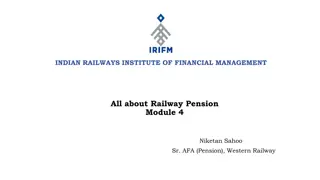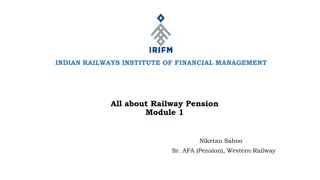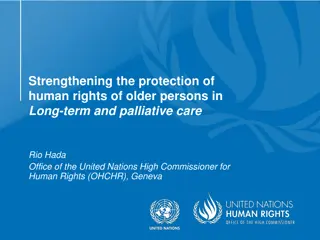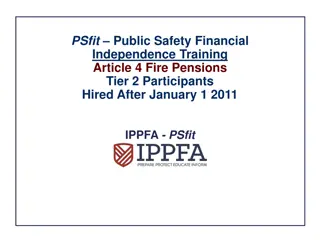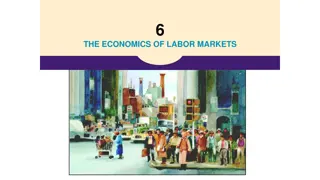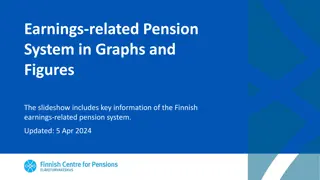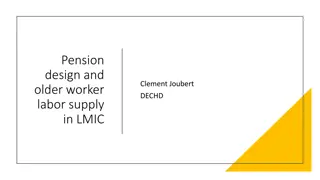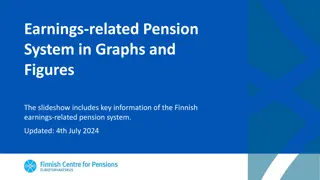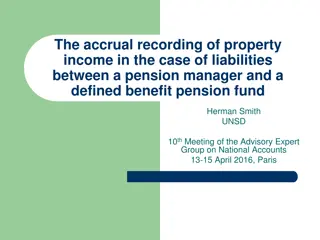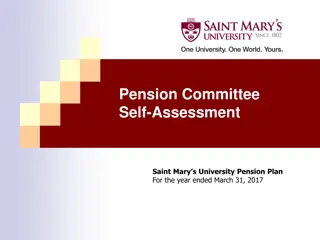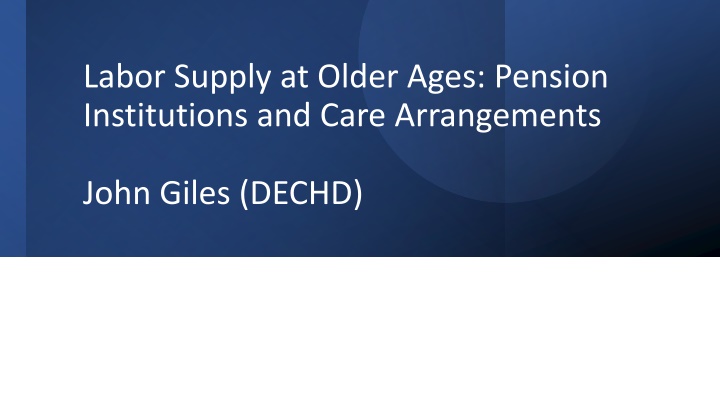
Labor Supply at Older Ages: Pension Institutions and Care Arrangements
This presentation discusses factors influencing labor supply at older ages, focusing on pension institutions and care arrangements, using observational data from HRS-type surveys in China and other international studies. It explores how family care arrangements impact the well-being and labor supply of care providers, presenting ongoing research and potential areas for collaboration in project evaluations.
Download Presentation

Please find below an Image/Link to download the presentation.
The content on the website is provided AS IS for your information and personal use only. It may not be sold, licensed, or shared on other websites without obtaining consent from the author. If you encounter any issues during the download, it is possible that the publisher has removed the file from their server.
You are allowed to download the files provided on this website for personal or commercial use, subject to the condition that they are used lawfully. All files are the property of their respective owners.
The content on the website is provided AS IS for your information and personal use only. It may not be sold, licensed, or shared on other websites without obtaining consent from the author.
E N D
Presentation Transcript
Labor Supply at Older Ages: Pension Institutions and Care Arrangements John Giles (DECHD)
Outline of Talk CHARLS and HRS-type Observational Data (DECRG collaboration since 2007) Descriptive Evidence on Factors Influencing Labor Supply Family Care Arrangements: Impacts on the Well-Being and Labor Supply of Care Providers Ongoing work using observational data Possible area for collaboration in project evaluations?
HRS Family of Surveys and other Health Surveys in China International HRS Surveys Other Surveys in China US HRS 1992 Chinese Longitudinal Healthy Longevity Survey (CLHLS) UK ELSA 2002 Europe SHARE 2004 China Health and Nutrition Survey (CHNS) Japan JSTAR 2007 Korea KLoSA 2008 China Kadoorie Biobank (CKB) Indonesia: since 1998 Not as representative India LASI 2014 Mexico 3 Gateway to Global Ageing: https://g2aging.org/ Brazil South Africa
CHARLS Timeline 2021 -22 2008 2009 2010 2011 2012 2013 2014 2015 2016 2017 2018 2019 2020 Life History 4thwave +HCAP Covid-!9 Special Survey 3rdwave 5thwave 2ndwave Two-Province follow-up Oral History National Baseline Two Province Baseline 4
A variety of indicators Indicators Gender, age, education, marriage, household registration, migration, family Household income, employment/work, expenditure, wealth, pension, housing conditions, family structure ADLs/IADLS, diagnostic histories, bio-markers, cognition, smoking, alcohol consumption, weight, exercise, sleep Knowledge of disease prevention and control, mental health literacy Accessibility of medical facilities, health insurance, medical service utilization Air pollution, green space environment Demographics Socioeconomic status Health status and behaviors Health literacy Healthcare accessibility Enviornmental factors 5
CHARLS Publications Published (as of October 6, 2022) Chinese journals: 1370 English journals: 1828 Chinese Dissertations: 548 English Dissertations: 117 English book chapters: 53 ... Total : 4034 4500 4000 3500 548 548 101 101 3000 487 487 43 43 2500 1828 1828 433 433 2000 1446 1446 32 32 54 54 365 365 1500 1128 1128 31 31 308 308 688 688 1000 21 21 255 255 428 428 1370 1370 270 270 1150 1150 500 910 910 748 748 577 577 440 440 303 303 0 2010 2011 2012 2013 2014 2015 2016 2017 2018 2019 2020 2021 2022 Journal_Chi. Journal_Eng. Dissertations_Chi Dissertations_Eng. Books and Book Chapters_Chi Books and Book Chapters_Eng. Cofference_Chi. Conference_Eng. Report_Eng Working_paper_Eng. 6
Retirement in China by Urban and Rural Registration Status
Retirement Rates by Hukou Status 8 Source: Giles et al (JPEF, 2023) using data from CHARLS (2018).
Retirement Rates in International Context Source: Gateway to Global Aging and CHARLS 2018. 9
Unconditional Retirement Hazard Rates Hazard rates at each age are defined as the percentages of those who exited employment at the age among those who exited no earlier than the age. Source: Giles et al (JPEF, 2023) using data from CHARLS (2018). 10
Evidence from Labor Supply Models Retirement patterns are very different in urban and rural China Rural elderly work until dropping Retirement (Exit from Work) is strongly associated with Mandatory retirement ages for workers covered under the urban employee pension (formal sector workers) Greater coverage and generous pension in urban areas Own health status => Disability hastens retirement in urban and rural areas A significant urban-rural gap in economic resources Policy implications for an aging China Urban residents should be encouraged to stay on the labor force longer: raising retirement age? facilitating gradual retirement? More generous social pensions for informal and rural workers, allowing the freedom to retire Joint retirement preferences: Raising women s retirement ages may lead to longer working lives for men as well. Source: Giles et al (JPEF, 2023) using data from CHARLS (2018). 11
Care Provision and Work/Employment
Policy Related to Long-Term Care China emphasizes a 90-7-3 model for provision of LTC. 90% in home (family support) 7% from community 3% institutional care Considerable effort to develop community care centers, with various models. Often started with substantial subsidies, but not self- sustaining. In rural areas often very few services. Recent developments in telephone hotline and web-based services in urban areas. Cost, financing and staffing remain important problems for both community-based and institutional care
Strain on Traditional Care Arrangements Traditionally responsibility for care of infirm older persons has rested with the family. Children and spouses remain dominant care providers Older men needing assistance receive care from spouses Older women tend to receive more care from adult children Significant gender differences in extent to which care needs are met Only 1.5% of CHARLS 2020 respondents receive care from hired care providers (including facilities) Failure to meet care needs can have serious consequences for well- being: greater incidence of depression, psychological distress, more hospital admissions
Consequences of Out-Migration for Older Persons in Rural Areas As of 2011, 59% of older people (60 and above) live in empty nests. Living in an empty nest is associated with poorer health and cognition (Lei et al, 2015). Living alone is associated with poorer health compared with those living either with a spouse or children (Zhou et al, 2018). Those living alone may yet have children nearby, but those this will change as the extended family size of older people continues to decline. Share of children of older persons living outside their home county increased from 48% in 2011 to 57% in 2018.
With Migration of Younger Cohorts, Population Aging is More Pronounced in Rural Areas Projected Dependency Ratios for Urban and Rural China, 2008-2030 40.0 Rural Urban Old Age Dependency Ratio (%) 30.0 20.0 10.0 Low TFR, Medium 0.0 2008 2009 2010 2012 2013 2015 2016 2017 2019 2020 2021 2023 2024 2026 2027 2028 2030 2011 2014 2018 2022 2025 2029 Source: Cai, Giles, O Keefe and Wang (2012)
Number of living children among the adults aged 50+ from CHARLS data Source: Chen et al 2022 (The Path to Healthy Aging in China, Lancet)
Where Should Older Persons Live? When an older parent becomes infirm, there is a strong return migration response (Giles and Mu, 2007), and this has significant consequences for family earnings. Several factors complicate movement of older persons to the city with adult children: oGeographic fragmentation of health insurance and pension systems oRemaining vestiges of the residential registration (hukou) system (access to public LTC facilities based on hukou status) oFear of losing option value of access to land (weakness in the land tenure system) oCost of housing in urban areas
Evidence of Effects of Providing Care on Care Providers US HRS: Long-term care provision may be associated with increases in depressive symptoms and poor self-rated health (Coe and Van Houtven, 2009) Overall international evidence seems mixed: Providing care is a prosocial behavior and may yield stress buffering adaptations (e.g., Roth et al, 2018). In China, providing care yields an additional source of stress as it draws care- providers out of the work force. Evidence from the "oldest-old" survey using 895 matched pairs: a caregiver's low income and status as an "eldest son" increased the likelihood of suffering economic stress
Impacts of Providing Care on Spouses Spousal care providers often provide higher quality care and have fewer other commitments (already out of workforce). Women frequently outlive spouses and are less likely to have spousal care providers. Ai and Feng (2020) use propensity score and differencing with CHARLS data in an attempt to examine impacts of providing care on health status of care providers. Significant impacts on well-being of women Appear to be attenuated when additional assistance is available
Impact of Providing Care on Spouse Well-Being Figure 5.1 Impact of Care Provision on Spouse Well-being by Gender 0.2 Female Male 0.15 0.1 0.05 0 -0.05 Source: Ai and Feng (2020) using data from CHARLS (2011, 2013 and 2015)
Impact of Providing Care on Spouse Well- Being with Additional Assistance Being by Gender and Assistance from Others Figure 5.2. Impact of Care-Provision on Spouse Well- Female with no assistance Female with assistance from others 0.30 Male with no assistance Male with assistance from others 0.25 0.20 0.15 0.10 0.05 0.00 Depression Physical pain At least one chronic disease Drinking Smoking -0.05 Source: Ai and Feng (2020) using data from CHARLS (2011, 2013 and 2015) -0.10 -0.15
Is Presence or Absence of Someone Requiring Care Associated with Labor Supply Decisions?1 Exploit the 2011 and 2013 Waves of the CHARLS Survey For those aged 45-65, Examine Change in Work Status (and other outcomes0 with Change in Number of Elderly Parents In Home, and then in Neighborhood or Home. (Why both?) Change in Elderly in Poor Health more Relevant. Not necessarily a negative effect on labor supply If additional health costs are imposed by providing care, one might expect an added worker effect and an increase in labor supply Grandparents and other older relatives may be providing housing or childcare and facilitating work. An older person with minor disability may yet be providing some childcare. Does incidence of depression (CESD-10) change with presence of parents? Allocation of time to leisure/social activities? 1Giles, Jiang and Zhao (in process)
Estimate First-Differenced Models at Household and Neighborhood (Village) Level ? + ??+ ??? ???= ?1 ?????????????+ ?? and alternatively ? + ??+ ??? ???= ?1 ?????+ ?2 ??????+ ?? Change in labor supply for adult aged 45-65 is a function of number of elderly parents, changes in marital status, changes in number of living parents, changes in respondents ADL status and city-level fixed effects, ??(to control for city-specific shocks and growth). ? includes 2011 levels of education, age and age-squared: in levels corresponding to differential trends related to differences in retirement probabilities at age and education levels.
When an Infirm Parent or in When an Infirm Parent or in- -Law Lives in the Home: Lives in the Home: Law Urban Areas Urban Areas Presence of older person, whether healthy or not, is not associated with decrease in work. (Retirement occurs first) Men and women report spending 16.9 and 13.9 more hours per week providing care, respectively. Women spend 61% less time on social activities outside the home when an infirm parent or in-law lives in the home. No difference for men. Women are 14% more likely to be suffering from depressive symptoms. No difference for men. Results are attenuated and less significant if expanding to include parents or in-laws in the neighborhood.
When an Infirm Parent or In When an Infirm Parent or In- -Law Lives in the Home: Lives in the Home: Law Rural Areas Rural Areas Men and women are 11% and 8% less likely to work, respectively. Women work 6 hours less per week if parent or in-law is village (including home). No change in work hours of men. Men and women report spending 21.8 and 15.6 more hours per week providing care. No impacts on reported depressive symptoms nor on leisure activities outside the house.
Possible Area for DEC Possible Area for DEC Operations Collaboration Collaboration Operations Identification problems when examining impacts of care provision with observational data are daunting. D-i-D with phase in of long-term care insurance? Not convincing in China. Introduce randomization into pilot programs supporting care (social care, light care) in home or community, examine impacts on labor supply and well-being: Subsidies to pay for assistance Placement of community activity centers Training of volunteers among young retirees More formal, Time Banks and their operation. (An almost project in Guizhou China)
Pension Type, Coverage (%) and Monthly Benefit (Yuan): ages above 60 Pension Type Employee Pension Firm's Pension Government or Institutions' Pension Resident Pension New Rural Social Pension Urban Residents' Pension Urban and Rural Residents' Pension Commercial Pension Other Pension Any Pension Urban 78.8 59.1 18.5 20.3 Rural 4.8 3.5 0.8 84.3 62.4 1.1 17.6 2.4 3.9 88.3 Total 26.9 20.2 6.1 65.1 44.4 2.3 14.0 3.3 3.7 90.1 Benefit 2,880 2,600 4,000 95 90 2.3 5.3 5.6 5.3 3.1 94.4 1,000 100 500 900 125 Source: Giles et al (JPEF, 2023) using data from CHARLS (2018). 29
Rural and Urban Residents Differ in Expected Rural and Urban Residents Differ in Expected Primary Source of Financial Support Primary Source of Financial Support Expected Expected Source Source of of Financial Financial Support Support Type Type ( (% %) ) Total Men Women Type Type Urban Rural Urban Rural Urban Rural 12.4 67.6 9.7 64.2 15.4 70.8 Children Children 1.8 4.2 2.3 5.6 1.3 2.9 Savings Savings 82.8 20.8 85.6 22.0 79.7 19.6 Pension Pension 3.0 7.3 2.5 8.1 3.6 6.7 Other Other 3,317 13,023 1,777 6,121 1,540 6,902 Observations Observations Data Data source source: : CHARLS CHARLS survey, survey, 2018 2018. . All All numbers numbers are are weighted weighted. . 30



